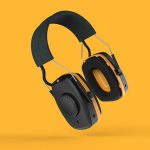 Headphones have become an unquestionable fashion item in recent years, but there have also been a number of fascinating innovations that give the humble headphone some serious health benefits.
Headphones have become an unquestionable fashion item in recent years, but there have also been a number of fascinating innovations that give the humble headphone some serious health benefits.
For instance, Kokoon are headphones that you can wear to bed to help you sleep better. They play an audio feed to help the wearer relax and get to sleep. The technology also uses EEG sensors to adapt to the users environment, slowly quietening as they drift off.
Or you’ve got ShoeBOX, which is an affordable audiometer system. The user wears a set of calibrated headphones, and the screen will display a range of icons associated with each game. Whenever the user hears a tone, they drag and drop the icon into one of the buckets on screen. In a typical game, the user will be tested on 4 frequencies, with the full test taking just one minute per frequency.
The results generated by the system are identical in quality to those produced by conventional equipment, with an audiogram produced at the end of each game that can be used by the medical professional that referred the user to the game to then take things to the next stage.
Safe communication
Arguably of more interest however are a number of projects aiming to make communication possible in noisy workplaces. Protecting workers from hearing damage means that many workplaces offer employees ear protectors. Whilst these help to protect their hearing, they make communicating very difficult.
One startup that’s attempting to change that is Eartex. They’ve developed headphones that are capable of blocking out the dangerous noises found in many industrial workplaces, whilst still allowing through human voices to allow workers to effectively communicate with one another. The devices use digital signal processing akin to that found in many hearing aids to amplify speech, all whilst attenuating harmful noise to safer levels.
This is crucial as it means that the worker isn’t completely deaf to the noises around them, but they are nonetheless protected from the 80dB or so of noise that is considered dangerous to their health. The system also comes with IoT sensors so that managers can continuously monitor the noise in the workplace, thus allowing occupational health staff to generate noise maps in real-time and develop personalized exposure data for each employee.
A team from the University of Bristol are working on a similar project. Their venture, known as Project Telepathy, works via a speaker that is worn on the head or chest. Four electrodes are then attached to the lips and jaw of the user, and measure facial movements as the user speaks. The electrodes then send a narrow ultrasonic beam that can only be heard by someone directly in its path. The beam can be paired with an eye-tracking camera or laser pointer to make it even more accurate.
The team have thus far developed an algorithm that can accurately detect 10 words, with the next step to significantly expand the vocabulary of the system and to reduce the size of the equipment required.
“It’s a very quiet sound, but you don’t know where it’s coming from,” the team say. “It’s like someone is whispering into your ear, but nobody is there.”
Suffice to say, interesting though the project is, it’s still a way from market, unlike Eartex, who have already been trialing their system with industrial heavyweights such as GE and Van Oord. It’s a nice example of how headphones are moving away from being ‘just’ a fashion accessory towards providing real societal value. It will be fascinating to see just where the projects mentioned above go next.